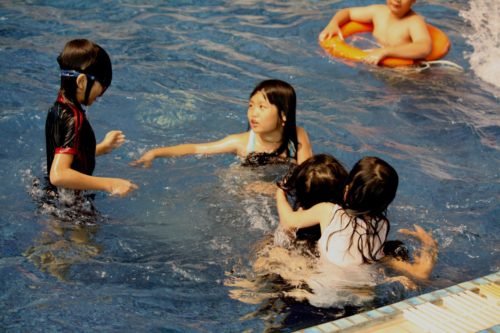written by Amy B. Shepherd, M.D.
With summer break upon us, most are happy to swap hours in the classroom with relaxing days at the pool or beach. Unfortunately, this increased time spent in the water can lead to swimmer’s ear. This condition is commonly seen in our pediatric office every summer. Swimmer’s ear (otitis externa) is an infection of the outer ear canal. It is most often caused by the water that remains in the ear canal after swimming. The resultant moist environment is perfect for the growth of bacteria which then invade the skin inside of the ear canal causing the infection. Ear pain is the most common sign of swimmer’s ear, and the pain is worsened by pulling on the outer part of the ear. Other symptoms frequently associated with it include redness, warmth, and/or swelling of the ear canal as well as ear drainage. More severe cases can result in muffled hearing, pain that extends beyond the ear, enlarged lymph nodes, and blockage of the ear canal.
Swimmer’s ear generally lasts about a week, and in some mild cases, it may resolve on its own. However, most seek medical treatment in order to decrease the pain, shorten the duration of symptoms, and keep the infection from getting worse. Typically, an antibiotic ear drop (often times combined with a steroid) is prescribed for the treatment of swimmer’s ear. Also, ibuprofen and/or acetaminophen can be helpful for pain control. In more severe cases, the physician may need to insert a wick into the canal to aid in the administration of the medication to the affected area. During any type of treatment, try to keep the ears dry. There should be no swimming. When bathing or showering, use a cotton ball coated with petroleum jelly to protect the ears. Also, do not put anything into the ear canals such as earbuds, ear plugs, or hearing aids until the pain has stopped.
There are some things parents can do to avoid swimmer’s ear. First, try to keep the ears dry. After swimming, wipe away any excess water with a towel. Encourage your child to tip his head to the side to allow for the water to drain from the canal. There is an at-home preventive treatment that can be used as long as there is no perforation or rupture of the eardrum and no ear tubes are present. By mixing one part white vinegar and one part rubbing alcohol, you can make a preventive ear solution that can be used before and after swimming. Insert a couple of drops of the solution into each ear and let it drain back out. The alcohol will combine with the water in the canal and then evaporate out, and the acidity of the vinegar will keep bacteria from growing.

